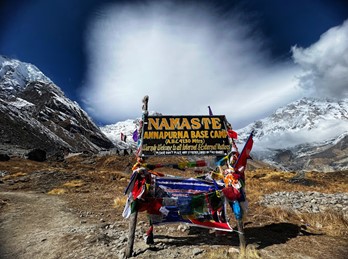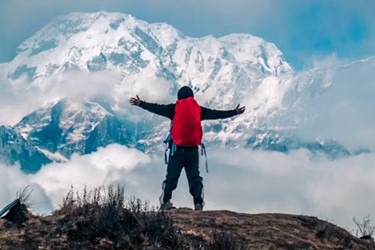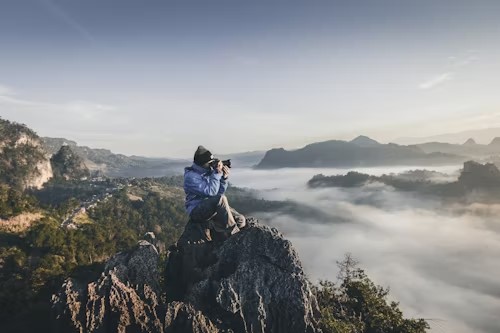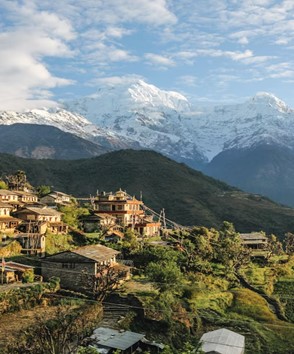Annapurna Hiking Itinerary: My Trail to Breathtaking Views


I did the Annapurna circuit trail in 2019 and it was an amazing experience . The Annapurna region of Nepal is incredible, especially the circuit trekking, where you will walk through the local villages , sometimes on suspension bridge , going through dirt road and surrounded by high peaks.
The most important thing is to get prepared for this long trek ( see below ) and have a good motivation . I took a bus to the starting point ( peoples at your hotel will tell you how to reach it ) , It doesn’t take a long time to do it ( they recommended 14 days and I did it in 8 days )
One of my favourite high-altitude treks I have done in my life and Pokhara is great place to get prepared or to chill after !
Description of Annapurna trekking in Nepal
Hidden away amongst the massive Himalayan peaks, Nepal’s Annapurna trekking experience unfolds as a voyage beyond the realm of typical exploration. This area, well-known for its stunning scenery and diverse culture, invites travelers to experience the majesty of the natural world and the friendliness of the people living here.
The varied ecosystems that adorn this area create a symphony that is the Annapurna trekking experience. The hike offers a feast for the senses, with pristine alpine meadows at higher elevations and lush subtropical forests at lower elevations. Trekkers can’t help but be in awe of the Annapurna massif, which is home to some of the highest peaks in the world. It dominates the skyline as they move across the diverse terrain.
Trekkers are treated to a spectacle of vivid blooms during the spring season as the trails wind through rhododendron forests, adding a painter’s touch to the already picturesque landscape. The Gurung and Thakali communities’ traditional ways of life and rich cultural heritage are glimpsed in the small villages that are tucked away like precious gems along the route.

PLAN OF THE ARTICLE :
- Introduction to Annapurna trekking in Nepal
- Annapurna Circuit Trek
- Annapurna Base Camp Trek
- Ghorepani Poon Hill Trek
- Jomsom Muktinath Trek
- Khopra Ridge Trek
- Mardi Himal Trek
- Sikles Trek
- Understanding the Difficulty Levels of Annapurna Trekking ( every routes detailed )
- Practice Details for Annapurna Trekking
- Tips for a Successful Annapurna Trekking Experience

Introduction to Annapurna trekking in Nepal

This journey is an adventure with a multitude of paths, each exhibiting its own distinct charm. Every stride feels the power of the Himalayas, whether you choose the shorter but no less magical Annapurna Base Camp Trek or the longer Annapurna Circuit Trek, which encircles the mountain range in a panoramic fashion.
The Annapurna region offers a spiritual and life-changing experience in addition to being a place to conquer high altitude. Not just tourists, but trekkers also become part of the environment, experiencing firsthand the pure mountain air, the tranquility of the alpine lakes, and the wild beauty of the surroundings. This deep experience is made even more rich by the cultural variety that is woven by the interactions with local people and their customs.
The sensory narrative of the Annapurna trekking experience is embodied by the visual illusion of snow-capped peaks, the melodious sound of mountain winds, the aroma of the local cuisine, and the palpable warmth of the local people. In this environment, the hike becomes a pilgrimage and a communion with the sublime forces of nature, transcending the physical effort.
Trekkers are treated to breathtaking views of the massive Dhaulagiri, the holy Machapuchare, and the majestic Annapurna I at every bend in the trail. These enormous places not only serve as geographical landmarks but also become traveling companions, providing motivation and a perspective on size that depresses people.
This overview captures the spirit of trekking in the Annapurna range and lays the groundwork for a more in-depth examination of its many aspects. We’ll dig deeper into the specifics that make this incredible journey unique, from the varied trekking options to the difficulties presented by the high altitudes.
Exploring the Diverse Trekking Options in the Annapurna Region
With its varied landscapes and attractive trails, Nepal’s Annapurna region, a treasure trove of natural beauty and cultural richness, tempts trekkers from all over the world. Trekking enthusiasts will find this region to be a haven as each route offers a unique tapestry of experiences, from the famous Annapurna Circuit Trek to the captivating Annapurna Base Camp Trek. In this piece, we set out to investigate the various trekking choices available in the Annapurna region, exploring the subtle aspects of each trail and the unmatched beauty they reveal.

1. Annapurna Circuit Trek

One of the most well-known trekking routes in the world, the Annapurna Circuit Trek attracts hikers with its expansive views and difficult landscapes. The Annapurna massif is encircled by this well-known route, which displays a remarkable range of environments, including alpine meadows, terraced fields, subtropical forests, and desolate high mountain deserts.
✔️ Highlights:
Thorong La Pass: The pinnacle of the trek, Thorong La Pass, is one of the world’s highest trekking passes, standing at an elevation of 5,416 meters. Trekkers are rewarded with breathtaking views of Annapurna and Dhaulagiri ranges.
Diverse Cultures: The circuit travels through a variety of ethnic communities, including Gurungs, Thakalis, and Manangis, providing a rich cultural tapestry.
✔️ Duration:
The Annapurna Circuit Trek typically spans around 18 days, covering approximately 230 kilometers. The trek is a test of both physical abilities and the spirit of adventure.
2. Annapurna Base Camp Trek

The Annapurna Base Camp Trek is a fantastic option for those looking for a more focused but still fascinating hike. Trekkers can experience an up-close encounter with the majestic peaks and an immersion into the heart of the mountain range by following this route, which drops them right to the foot of Annapurna I.
✔️ Highlights:
Machapuchare Base Camp: Enroute to Annapurna Base Camp, trekkers pass through the Machapuchare Base Camp, offering stunning views of the sacred Machapuchare, also known as the “Fish Tail” peak.
Annapurna Sanctuary: The base camp is situated in the Annapurna Sanctuary, a glacial basin surrounded by towering peaks, creating a surreal view of the mountains.
✔️ Duration:
Typically completed in around 10 days, covering approximately 115 kilometers, the Annapurna Base Camp Trek provides a more condensed yet no less rewarding adventure.
3. Ghorepani Poon Hill Trek

Trekkers looking for a slightly easier option or those with limited time can opt for the Ghorepani Poon Hill Trek, which provides an ideal combination of scenic views and cultural discovery. Even with its shorter length, this hike offers breathtaking views and a genuine cultural experience.
✔️ Highlights:
Poon Hill Viewpoint: The trek reaches its pinnacle at the renowned Poon Hill viewpoint, where trekkers are treated to a breathtaking sunrise panorama of the Annapurna and Dhaulagiri ranges.
Traditional Small Villages: The trail winds through traditional Gurung and Magar villages, providing an opportunity to immerse in local culture.
✔️ Duration:
Typically finished in 5 to 7 days, covering around 40 kilometers, the Ghorepani Poon Hill Trek is accessible to a wide range of trekkers, including beginners.
4. Jomsom Muktinath Trek

Trekking through the various landscapes of Mustang, the Jomsom Muktinath Trek offers a unique trekking experience that combines discovery of local culture with breathtaking natural beauty. The trek winds through scenic small villages and parched terrain before arriving at the holy location of Muktinath.
✔️ Highlights:
Jomsom’s Apple Orchards: Jomsom, known for its apple orchards, adds a unique flavor to the trek. Trekkers can savor locally grown apples along the route.
Muktinath Temple: The trek culminates at Muktinath, a significant pilgrimage site for both Hindus and Buddhists, adding a spiritual dimension to the journey.
✔️ Duration:
Completed in approximately 12 days, covering a distance of about 80 kilometers, the Jomsom Muktinath Trek provides a blend of natural wonders and cultural encounters.
5. Khopra Ridge Trek

In the Annapurna region, the Khopra Ridge Trek is a less well-known but no less captivating option for those who want to get off the main track and experience unspoiled environments. Trekkers will discover undiscovered treasures along the way, including stunning mountain views, genuine cultural interactions, and a feeling of isolation in the middle of the wilderness.
✔️ Highlights:
Khopra Ridge Panorama: The trek leads to Khopra Ridge, offering panoramic views of Annapurna South, Dhaulagiri, Nilgiri, and other neighboring peaks. The sunrise and sunset from this vantage point are nothing short of spectacular.
Community Lodge Experience: The trail promotes sustainable tourism by incorporating stays in community lodges, allowing trekkers to engage closely with local communities and experience the warmth of Nepalese hospitality.
✔️ Duration:
Typically completed in about 10 to 12 days, covering approximately 60 kilometers, the Khopra Ridge Trek strikes a balance between adventure and tranquility.
6. Mardi Himal Trek

The Mardi Himal Trek, a hidden gem that offers a more quiet trekking experience and reveals stunning vistas, is tucked away in the eastern section of the Annapurna range. Along the trek, hikers experience fewer tourists and a tranquil atmosphere while being rewarded with up-close views of Machapuchare and Mardi Himal.
✔️ Highlights:
Base Camp Experience: Although not as frequented as Annapurna or Everest Base Camps, Mardi Himal Base Camp provides a unique perspective of the surrounding peaks, including the formidable Machapuchare.
Rhododendron Forests: The trail passes through enchanting rhododendron forests, particularly vibrant during the spring season, adding a burst of color to the trek.
✔️ Duration:
Completing the Mardi Himal Trek usually takes around 7 to 10 days, covering approximately 64 kilometers. This trek is ideal for those seeking a quieter, off-the-beaten-path adventure.
7. Sikles Trek

The Sikles Trek is a hidden gem in the Annapurna region, offering a serene trekking experience while delving into the heart of Gurung culture. The trail offers a close-up view of the local way of life as it winds through terraced farms, historic settlements, and thick woodlands.
✔️ Highlights:
Gurung Villages: The trek passes through picturesque Gurung villages like Sikles, renowned for their unique culture, hospitality, and traditional practices.
Annapurna Range Views: Throughout the trek, trekkers are treated to stunning views of the Annapurna and Lamjung Himal ranges, creating a picturesque backdrop.
✔️ Duration:
Completing the Sikles Trek usually takes around 7 to 9 days, covering approximately 60 kilometers. This trek is an excellent choice for those seeking a cultural immersion off the main trekking circuits.
Understanding the Difficulty Levels of Annapurna Trekking
Starting a hiking excursion in the Annapurna region is a remarkable experience that unfolds challenges and victories in equal measure. This Himalayan paradise offers a variety of trekking alternatives, each with their own set of challenges requiring mental toughness, physical stamina, and a calculated approach to high altitudeexploration. Let’s examine in detail the nuances of the degrees of difficulty linked to some of the most well-known treks in the Annapurna region.


Annapurna Circuit Trek
✔️ Terrain and Altitude: The Annapurna Circuit Trek, spanning around 18 days, is a test of stamina and perseverance. Trekkers navigate a kaleidoscope of terrains, from verdant valleys to the barren landscapes of the Thorong La Pass, standing at a daunting 5,416 meters.
✔️ Challenges: The ascent to Thorong La is a formidable challenge, demanding acclimatization, physical strength, and resilience against the thinning air. Weather conditions at higher altitudes can be unpredictable, adding an element of unpredictability to this epic journey.
✔️ Reward: The payoff for overcoming these challenges is the unparalleled panorama from the pass, featuring the majestic Annapurna and Dhaulagiri ranges.
Annapurna Base Camp Trek
✔️ Moderate Challenge: While considered less strenuous than the Annapurna Circuit, the Annapurna Base Camp Trek spanning around 10 days presents its own set of challenges.
✔️ Gradual Ascents:Trekkers encounter gradual ascents, with some steeper sections, particularly in the final stretch towards the base camp. Adapting to the changing terrain requires steady endurance and acclimatization.
✔️ Scenic Terrain: The trek leads through lush forests, terraced fields, and alpine meadows, creating a varied but manageable challenge. The ultimate reward is the mesmerizing amphitheater of peaks at Annapurna Base Camp.
Ghorepani Poon Hill Trek
✔️ Introduction to Trekking: Recognized as one of the more accessible treks, the Ghorepani Poon Hill Trek spans 5 to 7 days, making it ideal for beginners and those with time constraints.
✔️ Manageable Daily Walks: Trekkers traverse well-maintained trails with shorter daily walks, making it a manageable yet rewarding journey. Some sections may involve steep ascents, preparing novices for varied terrains.
✔️ Poon Hill Sunrise: The challenge is sweetened by the breathtaking sunrise panorama from Poon Hill, surrounded by rhododendron forests during the spring, creating a trek that balances effort with stunning rewards.

Jomsom Muktinath Trek
✔️Moderate Difficulty: The Jomsom Muktinath Trek, completed in approximately 12 days, offers a moderate challenge, combining natural beauty with cultural exploration.
✔️ Altitude and Wind: As trekkers reach higher altitudes, acclimatization becomes crucial. The windswept Kali Gandaki Valley introduces a unique challenge, where gusts can test one’s balance and resilience.
✔️Cultural Richness:The trek introduces trekkers to the unique culture of the Mustang region, adding an extra layer of depth to the overall experience.
Khayar Lake Trek
✔️ Offbeat Choice: The Khayar Lake Trek, spanning around 12 days, is an offbeat choice, offering tranquility away from more frequented routes.
✔️ Solitude and Pristine Landscapes:The trail less traveled presents its own set of challenges, from less-defined paths to fewer facilities. However, the reward is the serenity of Khayar Lake and pristine landscapes, creating a unique and personal experience.
Recognizing the degree of difficulty of these journeys is not just about being physically ready; it’s also about accepting the difficulties as essential elements of the life-changing experience. Every challenge—the winding descent down the Kali Gandaki Valley, or the arduous climb up Thorong La—becomes a step towards self-realization and a closer bond with the breathtaking Himalayan scenery. May you reach the top of these obstacles and come away with a deep sense of satisfaction and appreciation for the beauty that surrounds you at every step.
Practice Details for Annapurna Trekking
Trekking in Nepal’s stunning Annapurna region is an event that changes people and requires careful planning in addition to being a physical adventure. Trekkers must become experts at Annapurna trekking through rigorous training and conditioning in order to negotiate the varied terrains, high elevations, and subtle cultural differences of this magnificent region. We go into the specifics of practice that are necessary to overcome obstacles and reap the greatest benefits from an Annapurna hiking journey in this extensive book.
Cardiovascular Fitness

✔️ Importance of Cardiovascular Endurance
A strong cardiovascular foundation is essential for a successful Annapurna trek. The paths, which wind through alpine meadows and subtropical forests, require long stretches of walking, thus cardiovascular stamina is essential. Increasing your heart and lung capacity will guarantee that you can take on the varied terrain with strength and endurance.
✔️ Training Activities
Engage in activities that elevate your heart rate and improve endurance. Hiking, jogging, and cycling are excellent choices. Focus on long-duration activities to mimic the prolonged walking periods you’ll encounter during the trek.
✔️ Altitude Simulation
Integrate altitude simulation into your cardiovascular training. Using altitude training masks during workouts helps your body acclimatize to reduced oxygen levels, a key aspect when trekking at higher elevations in the Annapurna region.

✔️ Building Strength Importance of Strength Training
Trekking in the Annapurna region requires maneuvering over a variety of terrain, which includes steep inclines and descents. Gaining strength is crucial to overcoming these obstacles, especially in your leg muscles.
✔️ Exercise Regimen
Incorporate strength training exercises into your routine. Squats, lunges, and stair climbing are effective for strengthening your quadriceps, hamstrings, and calf muscles. This conditioning prepares your muscles for the rigors of the trek.
✔️ Core Strength
Don’t neglect core strength, as it contributes to stability and balance. Planks, leg raises, and yoga can be valuable additions to your training regimen.
✔️ Altitude Simulation Importance of Altitude Simulation
One of the unique challenges of Annapurna trekking is the high altitude. Acclimatizing your body to thin air helps prevent altitude sickness and ensures a smoother journey.
✔️Training Techniques
If possible, engage in altitude simulation exercises. This can include using altitude training masks during cardio workouts or even spending time in hyperbaric chambers if available. These practices aid your body in adjusting to lower oxygen levels.

Nutritional Considerations
✔️ Importance of a Balanced Diet
Proper nutrition is crucial for sustaining energy levels during the trek. A well-balanced diet ensures your body receives the essential nutrients needed for endurance and recovery.
✔️ Carbohydrates for Energy
Emphasize carbohydrates in your diet, as they are the primary source of energy. Include whole grains, fruits, and vegetables to provide a sustained energy release.
✔️Proteins for Muscle Repair
Include lean proteins to aid in muscle repair and recovery. Chicken, fish, beans, and nuts are excellent protein sources.
✔️Gradual Ascent Training Importance of Gradual Ascent Training
Planning your training with a gradual ascent mimics the conditions of the trek. This approach helps your body acclimatize naturally to increasing altitudes, reducing the risk of altitude-related issues.
✔️Training Hikes
Incorporate training hikes into your routine with gradually increasing altitudes. This prepares your body for the elevation gains you’ll experience during the Annapurna trek.

✔️Rest Days
Build rest days into your training schedule. These days allow your body to recover and adapt to the physical stresses, minimizing the risk of overexertion.
✔️Rest and Recovery
Importance of Proper Rest
Rest is integral to physical preparation. It allows your muscles to recover, strengthens overall endurance, and reduces the risk of fatigue-related injuries.
Quality Sleep
Ensure you get sufficient and quality sleep during your training period. Adequate rest contributes to optimal physical and mental performance.
✔️ Consultation with Healthcare Professionals
Importance of Professional Guidance
Before embarking on any training regimen, consult with healthcare professionals. Their guidance ensures that your physical condition is suitable for the demands of Annapurna trekking.
Medical Clearance
Obtain medical clearance and professional advice to tailor your training program to your specific health needs. Addressing any underlying health concerns before the trek is crucial.

✔️ Preparing the Mind
Importance of Mental Preparation
Annapurna trekking is not only a physical challenge but a mental one. Mental conditioning prepares you to cope with the uncertainties, setbacks, and the sheer awe of the journey.
Visualization Techniques
Incorporate visualization techniques into your routine. Envision yourself successfully navigating challenging terrains and enjoying the breathtaking landscapes. This positive mindset can enhance your trekking experience.
✔️ Gear Familiarization
Importance of Quality Gear
Familiarize yourself with the trekking gear you’ll be using. Quality equipment ensures comfort, safety, and efficiency during the trek.
Trial Hikes with Gear
Conduct trial hikes with your trekking gear. This allows you to identify any discomfort or adjustments needed, ensuring a smooth experience on the actual trek.

✔️ Emergency Preparedness
Importance of Emergency Preparedness
While physical preparation is paramount, being ready for unexpected situations is equally crucial. Familiarize yourself with emergency procedures and contacts.
Emergency Contacts
Carry a list of emergency contacts, including local authorities, your embassy or consulate, and reliable contacts back home. This information can be vital in case of unforeseen circumstances.
Costs of Annapurna Trekking
When planning a trekking trip in the enchanting Annapurna region, expenses for everything from permits and lodging to supplies and guides must be carefully considered. A seamless and joyful trekking experience in the Annapurna region is greatly enhanced by careful planning and budgeting for these factors.
Permits

Annapurna Conservation Area Permit (ACAP): Allocate approximately ₹3,000 to ₹4,000 per person for the ACAP, which is essential for trekking within the Annapurna Conservation Area.
Trekker’s Information Management System (TIMS) Card: Budget around ₹1,000 to ₹2,000 per person for the TIMS card, a crucial document for trekking in Nepal.
✔️ Accommodation
Teahouses: Budgeting for teahouse accommodation, a common and cost-effective option along the trails, ranges from ₹500 to ₹1,500 per night.
Lodges: For those seeking more comfortable lodges, the cost may extend from ₹2,000 to ₹5,000 per night.
✔️ Guides and Porters
Guide: Hiring a guide, while enhancing safety and convenience, can cost approximately ₹2,000 to ₹4,000 per day.
Porter: Opting for a porter, though optional, can significantly ease the physical load and may cost between ₹1,500 to ₹2,500 per day.
✔️ Food and Supplies
Meals: Budgeting for meals is essential, with trekkers typically spending between ₹500 to ₹1,500 per day, depending on preferences and locations.
Water: Prices for bottled water may fluctuate at higher altitudes, ranging from ₹50 to ₹150 per liter.
✔️ Transportation
Flights: For those flying to Nepal, round-trip flights from India to Kathmandu can vary between ₹15,000 to ₹40,000, contingent on the airline and timing of booking.
✔️ Miscellaneous
Equipment Rental: If trekking gear needs renting, anticipate costs ranging from ₹500 to ₹2,000 per item, depending on the specific equipment.
Insurance: Securing comprehensive travel insurance with coverage for trekking at higher altitudes is crucial and may cost between ₹2,000 to ₹5,000.
Contingency and Miscellaneous Expenses
Contingency Fund: Allocate an additional ₹5,000 to ₹10,000 as a contingency fund to cater to unforeseen expenses or emergencies.
It is important to note that these cost estimates are approximate and may vary based on individual preferences, trekking routes, and external factors. The flexibility to adapt to potential fluctuations in expenses contributes to a more seamless and enjoyable Annapurna trekking experience.
Tips for a Successful Annapurna Trekking Experience
To ensure maximum enjoyment, safety, and cultural immersion, starting an Annapurna trekking adventure requires more than just physical preparation. It also requires a strategic approach. The extensive advice that follows will act as a roadmap for an enjoyable and fruitful hike through the breathtaking Annapurna region.


✔️ Acclimatization is Key
Gradual Ascent: Plan your trek itinerary with a gradual ascent, allowing your body to acclimatize naturally to the increasing altitudes. Rushing can lead to altitude sickness.
Rest Days:Incorporate rest days into your schedule to facilitate acclimatization. Use these days to explore nearby attractions and allow your body to adjust.
Stay Hydrated: Adequate hydration supports acclimatization. Ensure you drink plenty of fluids, as dehydration can exacerbate altitude-related issues.
✔️ Physical Preparation
Cardiovascular Fitness: Improve cardiovascular endurance through activities like hiking, jogging, or cycling. Focus on sustained exercises to prepare for prolonged periods of walking.
Strength Training: Strengthen your leg muscles with exercises like squats, lunges, and stair climbing to cope with the varied terrains encountered during the trek.
Altitude Simulation: If possible, simulate higher altitudes using altitude training masks. This can help your body adjust to reduced oxygen levels.
✔️ Pack Wisely
Essentials: Pack layers for varying temperatures, a high-quality trekking backpack, and sturdy hiking boots. Ensure you have essentials like a first aid kit, water purification tablets, and a good sleeping bag.
Altitude-related Items: Carry medications recommended by a healthcare professional for altitude sickness prevention. Items such as Diamox can be beneficial.
Snacks: Bring energy-boosting snacks to stay fueled during the trek. Nuts, dried fruits, and energy bars can provide a quick source of nutrition.

✔️ Respect Local Culture
Interact Respectfully: Engage with locals respectfully, appreciating and respecting the cultural nuances of the communities you encounter. Learn basic local phrases as a gesture of goodwill.
Dress Modestly: Respect local customs by dressing modestly, especially in more traditional small villages. This reflects cultural sensitivity and promotes positive interactions.

✔️ Stay Hydrated and Nourished
Balanced Diet: Maintain a balanced diet, ensuring you are well-nourished to support the physical exertion. Include a mix of carbohydrates, proteins, and healthy fats in your meals.
Hydration: Stay well-hydrated, as dehydration can exacerbate altitude-related issues. Carry a reusable water bottle and drink water regularly throughout the day.
✔️ Insurance and Permits
Travel Insurance: Obtain comprehensive travel insurance with coverage for trekking at higher altitudes. Confirm that the insurance covers potential evacuation costs in case of emergencies.
Permits: Ensure you have all necessary permits, including the Annapurna Conservation Area Permit (ACAP) and Trekker’s Information Management System (TIMS) card.
✔️ Weather Considerations
Be Prepared for Varied Weather: Pack accordingly for a range of temperatures, from warm valleys to cold mountain passes. Check weather forecasts regularly to adjust your clothing and gear accordingly.
Rain Gear: Include rain gear in your packing list, especially if trekking during the monsoon season. A good quality rain jacket and waterproof pants can be essential.

✔️ Photography Tips
Camera Precautions: Batteries tend to drain faster in cold temperatures. Carry spare batteries and keep them warm to ensure your camera remains functional. Protect your equipment from moisture and cold.
✔️Responsible Trekking
Leave No Trace: Follow the principles of responsible trekking by minimizing your environmental impact. Carry out all waste, and avoid disturbing local flora and fauna.
Support Local Businesses: Contribute positively to local communities by choosing local products and services. This helps sustain the local economy and fosters a sense of mutual respect.

✔️ Emergency Preparedness
Emergency Contacts: Carry a list of emergency contacts, including local authorities and your embassy or consulate. Share your itinerary with a reliable contact back home.
Know Evacuation Procedures: Familiarize yourself with evacuation procedures in case of emergencies. Be aware of the location of medical facilities along your route.
By incorporating these tips into your preparation for your Annapurna trekking, you will not only increase your safety but also guarantee a more fulfilling and enjoyable experience. Experience the stunning scenery, engage in responsible trekking, and relish the distinctive cultural events that the Annapurna region has to offer.

Conclusion
Armed with the knowledge and advice you need to tackle the Annapurna trekking adventure, you are ready to set off on an incredible adventure. With its breathtaking landscapes, dynamic cultures, and towering peaks, the Annapurna region entices visitors with the promise of an extraordinary experience.
Every step you take will open a new chapter in your adventure, whether it’s the high altitude challenges of the Annapurna Circuit Trek or the tranquil beauty of the Annapurna Base Camp Trek. This trek is a symphony of exploration and self-discovery because of the charming small villages, the grandeur of higher altitudes, and the cultural tapestry woven into the fabric of the region.
Walking the Annapurna circuit in Nepal is a spiritual journey that takes you closer to the breathtaking Himalayan scenery with each step you take. It’s more than just a physical adventure. Put on your boots, take in the fresh mountain air, and revel in the majesty of the Annapurna region. This trekking adventure is sure to leave a lasting impression.
Safe travels, adventurer! May your Annapurna trek be filled with awe, inspiration, and the joy of discovery.
Hello !
I am Eric, a French Australian citizen based between Australia, Asia and Bali and I love to travel and experience the world. I generally like outdoor activities, wellness, great food and venues , party and real local adventures ! I am a Yoga practitioner and fitness lover
I created this blog because I love to travel and I want to share my experiences with others. I’ve been traveling since I was a child, and I’ve been to over 50 countries. I’ve seen some amazing things and met some amazing people, and I want to help others experience the same things.
I believe that travel is one of the best ways to learn about the world and about yourself. When you travel, you’re forced to step outside of your comfort zone and experience new things. You learn about different cultures, different religions, and different ways of life. You also learn about yourself, your strengths, and your weaknesses.
Travel can also be a great way to make new friends. When you’re traveling, you’re surrounded by people from all over the world, and you’re all in the same boat. You’re all there to explore and experience new things, and that can create a bond between people.
Let’s connect together !
I hope that my travel blog will inspire others to travel and to see the world. I also hope that it will help people to learn about different cultures and to become more open-minded.



![Backpacking Nepal Travel Guide: Tips from Pros [2025]](https://funkyfreshtravels.com/wp-content/uploads/2024/05/pexels-vome-6102867-768x512.jpg)



